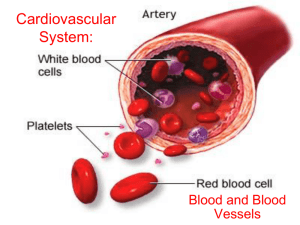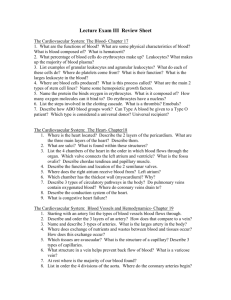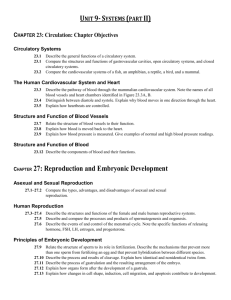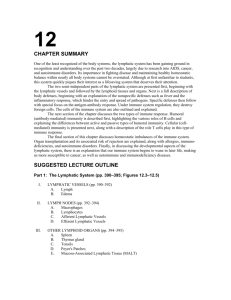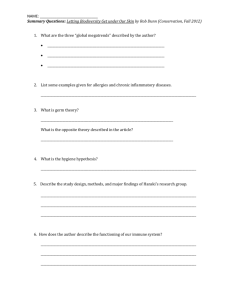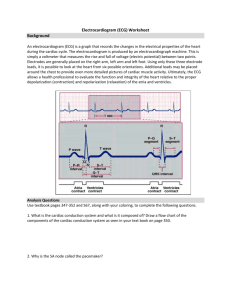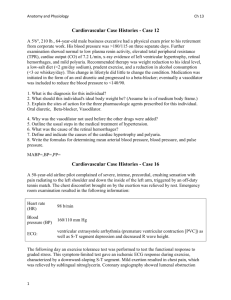Unit 5 Study Sheet - El Camino College
advertisement
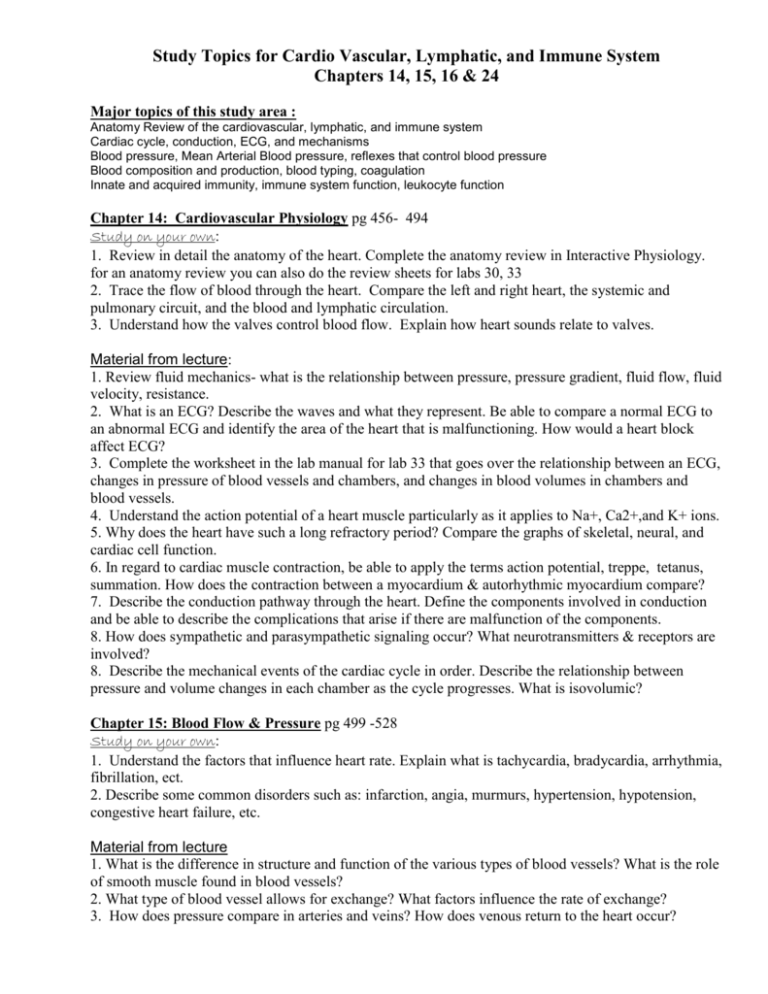
Study Topics for Cardio Vascular, Lymphatic, and Immune System Chapters 14, 15, 16 & 24 Major topics of this study area : Anatomy Review of the cardiovascular, lymphatic, and immune system Cardiac cycle, conduction, ECG, and mechanisms Blood pressure, Mean Arterial Blood pressure, reflexes that control blood pressure Blood composition and production, blood typing, coagulation Innate and acquired immunity, immune system function, leukocyte function Chapter 14: Cardiovascular Physiology pg 456- 494 Study on your own: 1. Review in detail the anatomy of the heart. Complete the anatomy review in Interactive Physiology. for an anatomy review you can also do the review sheets for labs 30, 33 2. Trace the flow of blood through the heart. Compare the left and right heart, the systemic and pulmonary circuit, and the blood and lymphatic circulation. 3. Understand how the valves control blood flow. Explain how heart sounds relate to valves. Material from lecture: 1. Review fluid mechanics- what is the relationship between pressure, pressure gradient, fluid flow, fluid velocity, resistance. 2. What is an ECG? Describe the waves and what they represent. Be able to compare a normal ECG to an abnormal ECG and identify the area of the heart that is malfunctioning. How would a heart block affect ECG? 3. Complete the worksheet in the lab manual for lab 33 that goes over the relationship between an ECG, changes in pressure of blood vessels and chambers, and changes in blood volumes in chambers and blood vessels. 4. Understand the action potential of a heart muscle particularly as it applies to Na+, Ca2+,and K+ ions. 5. Why does the heart have such a long refractory period? Compare the graphs of skeletal, neural, and cardiac cell function. 6. In regard to cardiac muscle contraction, be able to apply the terms action potential, treppe, tetanus, summation. How does the contraction between a myocardium & autorhythmic myocardium compare? 7. Describe the conduction pathway through the heart. Define the components involved in conduction and be able to describe the complications that arise if there are malfunction of the components. 8. How does sympathetic and parasympathetic signaling occur? What neurotransmitters & receptors are involved? 8. Describe the mechanical events of the cardiac cycle in order. Describe the relationship between pressure and volume changes in each chamber as the cycle progresses. What is isovolumic? Chapter 15: Blood Flow & Pressure pg 499 -528 Study on your own: 1. Understand the factors that influence heart rate. Explain what is tachycardia, bradycardia, arrhythmia, fibrillation, ect. 2. Describe some common disorders such as: infarction, angia, murmurs, hypertension, hypotension, congestive heart failure, etc. Material from lecture 1. What is the difference in structure and function of the various types of blood vessels? What is the role of smooth muscle found in blood vessels? 2. What type of blood vessel allows for exchange? What factors influence the rate of exchange? 3. How does pressure compare in arteries and veins? How does venous return to the heart occur? 4. Review the physics behind fluid mechanics as it relates to blood flow, what exceptions apply to the circulatory system and why? 5. Review the details on heart tissue. What purpose do intercalated discs serve? How is heart contraction different from smooth or skeletal muscle? 6. What is blood pressure? How is it measured? What factors would cause it to rise and fall? What is pulse and mean arterial pressure? What is the difference between systole and diastole? 7. What is cardiac output and stroke volume? Be able to calculate cardiac output (bring calculator to test). What factors affect heart rate and stroke volume? What is Starling’s Law and how does it relate to heart function? 8. What ensures the flow of blood in one direction only? How do multiple systems compensate for increase and decreased blood volumes? Chapter 16: Blood pg 536-554 (No need to go into in-depth detail on coagulation steps) Study on your own: 1. Describe some common blood disorders such as: jaundice, anemia, leukemia, etc. 2. Complete the review worksheet for lab 32 and the physioex blood lab Material from lecture 1. What are the components that make up blood? Include the cellular, non-cellular, and fluid components. Know the approximate percentages of each. What does blood carry that makes it useful for diagnostics? 2. What is the life cycle of a red blood cell? Where are they produced? What is their function and structure? What happens to RBCs once their life span is over? 3. What hormones and organs are involved in the production of all blood cells? 4. How does blood clotting happen? What components are involved? 5. Understand the ABO blood groups and Rh factors. How is blood type determined? Chapter 24: Immune System pg 776-800 ( not covering neuro-endocrine-immune interactions) Study on your own: 1. Review the anatomy of the lymphatic system. Describe the lymphatic system and lymph organs. List the components. Describe its structure and function. What is the distribution of lyphoid tissues throughout the body? 2. You can complete the review sheet for lab 35 to get an anatomy review. 3. Describe some common disorders such as: edema, allergies, immune disorders, AIDS Material from lecture 1. List the types of white blood cells and their functions 2. What are the various ways that the body prevents infection from happening? 3. Describe the various types of immunity, including specific and non-specific immunity, innate, acquired, active/passive immunity. What components are responsible for them? How do they function? 4. Describe the immune response pathways including inflammation, allergies, MHC recognition, immune surveillance, and intracellular defense mechanisms. 5. Describe how B and T cells mount and immune response to fight disease. How are lymphocytes activated? 6. What are MHC molecules? How do they interact with T cells? What is antigen presentation? 7. What is compliment? What happens when an antigen binds to an antibody? 8. What is the role of antibiotics? How is a viral infection different from a bacterial infection? 9. How are allergies different from true infections?
